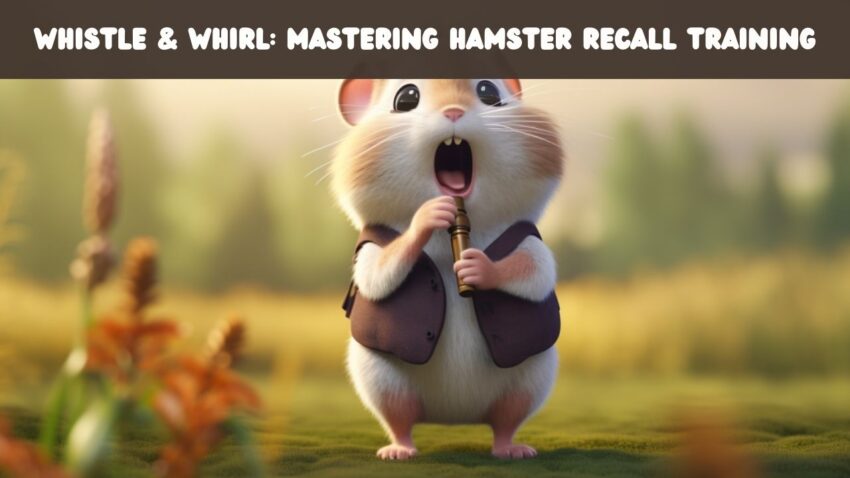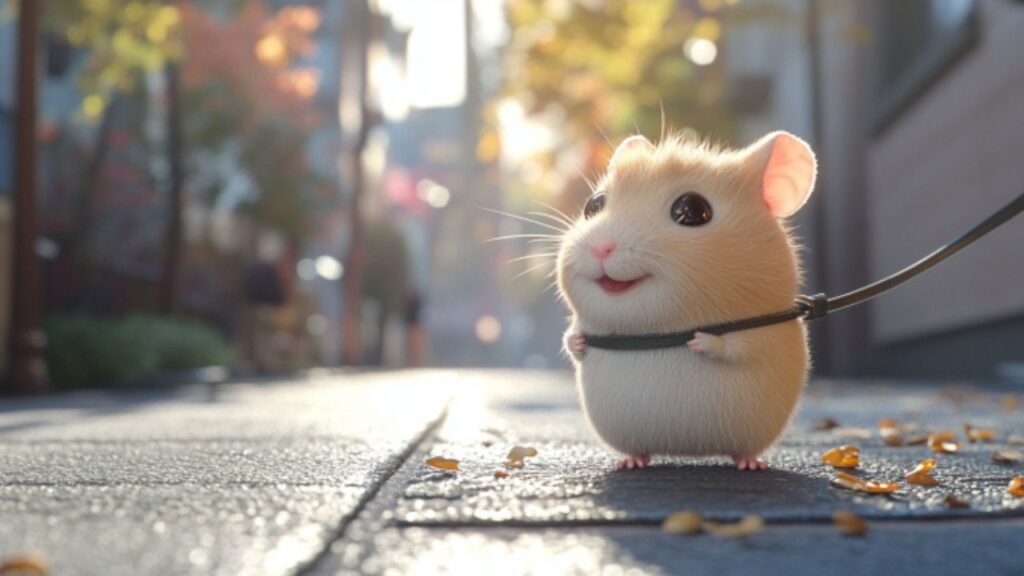Hey there, fellow hamster enthusiasts! 🐹👋 It’s your friendly hamster guru, Hannah Hammie. Today, we’re embarking on a fascinating journey into the world of Hamster Recall Training. Now, I know what you might be thinking—“Recall? For a hamster? Really?” Oh, absolutely! These little furballs are packed with potential, and with the right techniques, they can surprise you in ways you’ve never imagined. Whether you’re a first-time hamster parent or a seasoned pro, there’s always something new to learn. So, let’s dive deep, uncover some hamster secrets, and build an even stronger bond with our tiny, whiskered pals. Ready to get started? Let’s roll! 🐹🎡
The Recall Revelation 🐹✨
Hello, dear neighbors over the digital fence! Hannah Hammie here, and today I’ve got a real treat for you. You might think of hamsters as those adorable furballs that run tirelessly on wheels and nibble on just about everything. But did you know these little munchkins can be trained to recognize and even come to specific sounds or cues? That’s right! Hamsters, with their tiny twitching noses and ever-curious eyes, have an astonishing ability to remember and respond, turning our assumptions of them being just aimless runners upside down. It’s not magic—it’s all about understanding the science and psychology of these wee creatures.
Bonding Over Bells 🔔❤️
Now, let’s dive a bit deeper, shall we? Hamster Recall Training is more than just teaching Fluffy to come to a bell or a whistle. It’s about building trust. It’s about those moments when your tiny friend stops, looks up, and decides, “Oh, that’s my human calling! Better go see what’s up!” 🐹💨. Every time they respond to your cue, they’re not just seeking a treat (though that’s a delightful bonus); they’re acknowledging the bond you’ve been building. It’s a heartwarming affirmation of trust and connection, and it’s genuinely a two-way street. You learn to understand them better, and they get to feel safe and loved in your presence. So, are you ready to embark on this incredible journey of bonding and bells with me? Let’s get that hamster wheel turning in a whole new direction!
The Science of Hamster Recall:

Ever paused and wondered just how much is going on in that tiny, furry head? Well, as it turns out, our hamsters have a lot more going on upstairs than we often give them credit for. Let’s unravel some of these mysteries, shall we?
Brainy Ball of Fur
“Little body, big brain!” might as well be the hamster’s motto. 🧠🐹 Recent scientific studies have showcased the surprisingly advanced cognitive abilities of hamsters. Just like humans, hamsters have regions in their brains responsible for memory and learning. While they might not be writing novels or solving math problems (as far as we know! 😉), they do have the capacity to recognize, remember, and react to various stimuli. This not only helps them navigate their surroundings but also aids them in recalling where they’ve stashed their treats or which tunnels they’ve dug.
Sound Resonance
Now, onto the fun, musical side of things! 🎶 When we think of training, it’s easy to assume it’s all about treats and toys. But the world of sound plays a vital role, especially for hamsters. These critters have an acute sense of hearing, which is crucial for their survival in the wild. Auditory cues, be it the gentle chime of a bell or the calling of their name, resonate deeply with them. Hamsters can distinguish between different sounds, and with consistent training, they can associate specific sounds with particular actions or rewards. So next time you notice your hammy perking up its ears, remember: they’re always listening, always learning.
Isn’t nature just the best? Science has a beautiful way of reminding us how interconnected we all are. As we proceed, we’ll delve into harnessing this science to enhance our bond with our little pals. Onward! 🐹🌟
Preparing for Recall

Ah, the world of recall training! It’s not just about teaching; it’s about creating moments, memories, and melodies that’ll stick with both you and your hammy. Before you even think about starting, there are a few foundational steps you’ll want to take to ensure a smooth training experience.
Setting the Stage
Imagine you’re preparing for a big theatrical debut; the ambiance needs to be just right. Similarly, for our little stars, the setting matters. 🎭🐹
- Calm & Quiet: Choose a time and place that’s free from loud noises or distractions. A quiet room where both you and your hamster can focus is ideal. This ensures your hamster can clearly hear and recognize the sound cues without being overwhelmed.
- Safety First: If you’re training outside their cage, ensure the area is hamster-proofed. Remove any potential hazards, and ensure there are no places they can get stuck or hide in where you can’t easily reach them.
- Comfort Zone: Consider placing some familiar items around, like their favorite toy or a treat. It will give them a sense of security, making them more receptive to training.
Tools of the Trade
Okay, aspiring Hamster Whisperer, let’s talk tools. 🎶🔧
- Whistles: A whistle produces a clear, sharp sound that can easily capture your hamster’s attention. Look for one with a consistent tone. Over time, your hamster can associate this sound with a specific action or reward.
- Bells: These can be very effective, especially the ones with a gentle, clear chime. However, avoid bells that are too loud as they might startle your furry friend.
- Voice: Never underestimate the power of your own voice! Using a specific word or phrase consistently can become a recognizable cue for your hamster. Just ensure you use the same tone and pitch each time for clarity.
- Electronic Sound Devices: Some trainers swear by devices that play a particular tune or sound. They can be an excellent tool, especially if they have volume control, but always ensure the sound isn’t too loud or jarring for your little companion.
Remember, every hamster is a unique individual, so it might take a bit of experimenting to figure out which tool resonates best with your furry friend. But with patience and a sprinkle of creativity, you’ll both be dancing to the same tune in no time! 🎵🐹🕺
Hamster Recall Training Techniques

Ah, diving into the world of hamster recall training is reminiscent of composing an enchanting melody that lingers in one’s ears long after it’s played. 🎶 Just as every great song demands a precise blend of rhythm, heartfelt repetition, and that unique spark of creativity, shaping your hamster’s recall abilities requires a similar concoction of elements. The training journey is akin to writing a musical piece, each note representing a step towards achieving that flawless recall. As you string these notes together in harmony, what you’re really crafting is a symphony of trust, understanding, and mutual respect with your pint-sized companion. So, let’s roll up our sleeves and find out how you can orchestrate this beautiful concerto with your whiskered maestro. 🐹🎵🎹
From Hearing to Heeding
Training isn’t about demanding a response; it’s about communicating in a language they understand. Here’s how you can guide them from passive hearing to active heeding:
- Start Simple: Begin with a straightforward cue. If using a bell, a single, gentle ring might do the trick.
- Pair with Action: When you use your chosen sound or voice cue, pair it with a gentle action, like offering a treat or opening their cage door. This helps them make an association between the sound and a specific event.
- Short & Sweet Sessions: Hamsters have short attention spans. Keep your initial training sessions brief, say 5-10 minutes, but make them engaging.
- Increase Complexity Gradually: Once they start responding to the simple cue, increase the complexity. Maybe they come to a particular spot when they hear the sound, or perhaps they perform a little spin or twirl.
Reward and Recognition
This isn’t just a strategy; it’s a philosophy. Positive reinforcement is the heart and soul of effective training.
- Timely Treats: As soon as your hamster responds to the recall cue, offer a treat. It’s essential the reward is immediate, so they associate the action with the treat. 🍪🐹
- Vary the Rewards: While treats are great, also consider other forms of reward like a gentle petting session, playtime, or a new toy.
- Praise with Passion: Use an excited and cheerful voice to praise them when they get it right. They might not understand the words, but they sure can pick up on your happy tone!
Consistency is Key
Like any good habit, consistency in training cements the behavior.
- Regular Routines: Train at the same time and place every day. It helps set a pattern and expectation in your hamster’s tiny but mighty brain.
- Stick with the Sound: Whether you’re using a bell, whistle, or your voice, maintain consistency in the sound cue you use. Avoid changing it frequently.
- Persistent Patience: There will be days when they nail it and days when they’re just not in the mood. It’s okay. Keep going, and remember, every little progress is a step forward.
When you get down to it, recall training is as much about understanding your hamster as it is about teaching them. Stay attuned to their moods and preferences, and before you know it, you’ll both be in perfect harmony. 🎼🐹❤️
🎶 Common Challenges and Solutions 🎶

Ah, the intricate dance of recall training! 🩰 Like any relationship, the journey with your hamster will have its ups and downs. Remember, it’s all part of the crescendo towards perfect harmony. 🎼 But before we get there, let’s address the potential hiccups along the way.
🎧 Tuning Troubles: Addressing hamsters that struggle with differentiating between sounds 🎧
In the world of music, different notes carry different emotions and meanings. 🎵 For our little furballs, understanding these variations can sometimes be a tad tricky. It’s like trying to distinguish between a C and a C# on a piano without ever having touched one! 🎹
Why the confusion?
Hamsters have evolved to rely on their acute sense of hearing to navigate their surroundings. However, when introduced to multiple new sounds in quick succession, it’s not uncommon for them to experience some ‘frequency fumbles’. 🐹👂
The Remedy
- Simplify and Segregate: Begin by isolating one sound cue at a time. It’s like teaching a child a single musical note before expecting them to play an entire scale.
- Consistent Cues: Just as a musician practices the same tune repeatedly to perfect it, ensure you’re consistent with the sound cues you use. 🔄
- Sound Familiarization Sessions: Dedicate specific sessions where your hamster gets to just listen and familiarize. Think of it as their little “listening party”! 🥳🎧
🐹 Interest Issues: Rekindling a hamster’s enthusiasm when they seem disinterested 🐹
We’ve all been there – one day you’re all about jazz, and the next, you can’t stand another trumpet note. 🎺 Similarly, hamsters, with their ever-changing moods, might occasionally seem less than thrilled about the training sessions.
Understanding the Drift
It’s essential to recognize that hamsters, just like us, have their off days. Maybe they’re tired, or perhaps the tune of the day just isn’t hitting right. 💤🎶
Finding the Rhythm Again
- Mix It Up: Just as you’d curate a playlist to match your mood, try changing the type of sound cues occasionally. Maybe swap that whistle for a bell or even a gentle clap. Variety is, after all, the spice of life! 🔔👐
- Engage Their Curiosity: Remember, hamsters are innately curious creatures. Sometimes, introducing a new toy or treat can spark that lost interest. It’s like dropping a new beat in the middle of a song – unexpected but oh-so-refreshing! 🍭🎸
- Take a Breather: If your hamster seems persistently disinterested, it might be time for a short break. Let them roam, play, and just be. After all, every artist needs some downtime to find inspiration again. 🌄🖌️
And there you have it! 🎉 Challenges in hamster recall training might seem daunting at first, but with patience, creativity, and a sprinkle of fun, you’ll soon have your hamster dancing – or, well, running – to your tune. Remember, it’s all about finding that perfect rhythm together. 🐹❤️🎶
Hannah’s Training Tactics

Navigating the world of hamster training is like mastering a musical instrument; it takes patience, passion, and a sprinkle of panache. In this section, I, Hannah Hammie, will spill the beans on my personal favorites: the tactics I’ve fine-tuned over the years. Think of these as the secret notes to your hamster training symphony. Ready to orchestrate some harmonious moments with your little furball? Let’s dive into some insider secrets that can make your training sessions truly sing! 🎶🐹🎉
🎶 Whistle Wonders: Quick tips for using a whistle effectively in training 🎶
Ah, the whistle – a classic in the recall training arsenal. Just as a conductor uses a baton to guide an orchestra, a whistle can be your instrument of choice to guide your furry friend. Here’s how to wield it with flair:
- Start Soft: Hamsters have sensitive ears. Always start with a gentle blow, ensuring it’s not too shrill or startling. 🐹👂
- Consistent Cadence: Just as each song has its rhythm, maintain a consistent whistle pattern. Whether it’s two short blows or a long followed by a short, consistency is key. 🎵
- Location, Location, Location: Always whistle from the spot you want your hamster to come to. This helps them associate the sound with a specific location, almost like their personal GPS! 🌍
🐹 Sound Sensitivity: Understanding your hamster’s unique sound preferences 🐹
Think of your hamster as a little DJ. They have their own taste in ‘tunes’, and recognizing that is paramount.
- Observe and Adapt: Watch how your hamster reacts to different sounds. Do they perk up with higher pitches or seem more relaxed with lower tones? Observation is your best friend. 👀🎶
- Trial and Error: It’s all about experimentation. Play a range of sounds – from chimes to claps – and note which ones resonate most with your pet. 🎼
- Respect Their Preferences: Just as we might not enjoy heavy metal at 7 a.m., be mindful of the sounds your hamster seems to dislike and avoid them during training. 🤘❌
🔔 Bell Bliss: Harnessing the gentle ring of a bell to beckon your buddy 🔔
The bell’s gentle chime has a magical allure that can work wonders in recall training. But how do you ensure it’s music to your hamster’s ears and not just a jarring jangle?
- Choose the Right Bell: Not all bells are created equal. Opt for ones that emit a soft, melodious ring. Think more along the lines of wind chimes, less alarm clock! ⏰❌
- Ring Routines: Create a regular pattern when ringing. This could be two quick successive rings or perhaps a pattern of three with a pause in between. Rhythm is everything! 🎵
- Pair with Positive Reinforcements: Whenever the bell rings, and your hamster responds, reward them. This way, they’ll start associating the bell’s sound with positive vibes and treats! 🍭🔔
Remember, training is as much about understanding your hamster as it is about teaching them. With these tactics, you’re well on your way to orchestrating a beautiful symphony of sounds with your tiny companion! 🎶🐹❤️
Conclusion: A Symphony of Success

Ahoy, fellow hamster enthusiasts! 🐹💫 As we draw our melodious journey of recall training to a close, it’s time to pause, reflect, and revel in the harmonious bond you and your furry friend have composed. Just like the final movements in a symphony, this conclusion encapsulates our shared learnings, joys, and aspirations. From recognizing the first flutter of understanding in your hamster’s eyes to dreaming of the next training concerto, let’s wrap up this opus on a high note! 🎶🎉🐹❤️
Recall Revelations
Recall training with your hamster is not just a series of cues and responses; it’s a melody of trust, understanding, and companionship. Each time your little buddy responds to your call, it’s a testament to the bond you’ve nurtured and the hard work you’ve both put in. It’s a dance of tiny feet responding to a call, a harmonious blend of teaching and learning. These milestones, no matter how small, are worth cherishing. They’re the crescendos in your training journey, showcasing the progress you’ve made together. 🎉🐹💕
Beyond the Bell
But the musical masterpiece doesn’t end here. With the foundation of recall training laid, the world of advanced hamster training opens up to you. Whether it’s agility drills, maze runs, or even introducing new sounds and cues, the sky’s the limit. Imagine a performance where your hamster responds to a variety of instruments, each cue leading to a different adorable action. The journey of discovery, learning, and bonding continues, turning each training session into a symphonic blend of joy and accomplishment. 🎶🌟🐹
With paws and patience, you’re on the road to being a Hamster Whisperer. Happy training! 🐾❤️🎵




